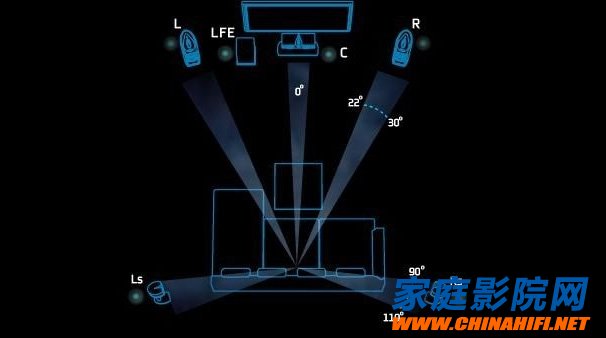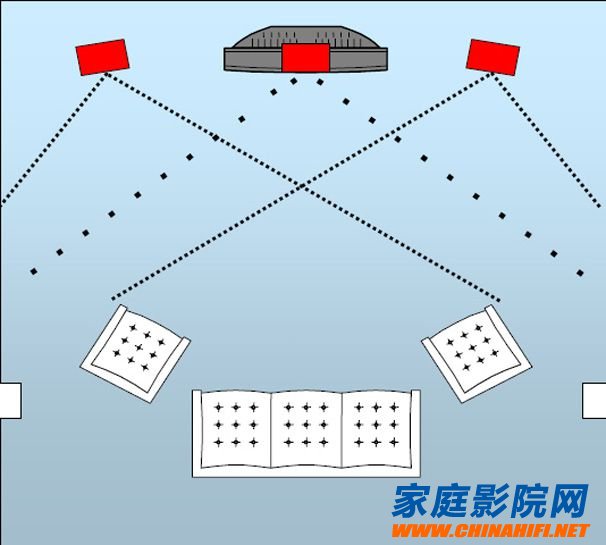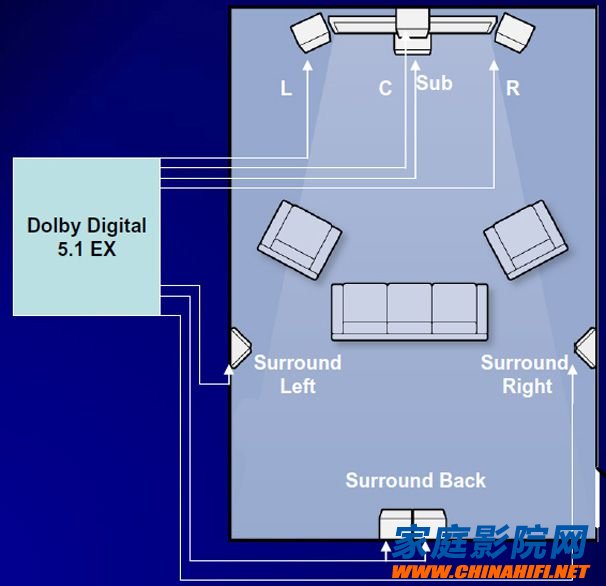It is very difficult to have a space certified by THX Labs. But this does not stop us from chasing the pace of high-fidelity home theater. We also introduced the THX standard: "THX Standard Surround Sound Design for Home Theater Speakers", and today I will talk about THX-certified home theaters in detail.
Recap history:
In 1983, George Lucas and Tomlinson Holman joined forces to create THX.
In 1985, the certification project for the film post-production studio began.
In 1991, the home theater certification program was launched.
In 1997, the certification of DVDs began. The first film was Tornado.
In 1998, THX's certification program covered the entire industry chain from audio and video production to terminal playback.
In 1999, the Surround EX technology was invented.
In 1999, he re-created the world’s first digitally-played movie, Star Wars I.
In 2002, became an independent company
In 2003, launched the game program certification project
In 2004, the car audio certification project was launched.
In 2006, launched the video product certification project
Launched the THX Loudness Plus project in 2008
THX, synonymous with professional cinema
THX, the word from the day of birth wrapped a professional and authoritative coat. In the decade when digital audio-visual products entered the home in large numbers, our THX logos are increasingly appearing around us. In addition to traditional DVDs, DVD players, amplifiers, stereos, THX is available in TVs, projectors and cars. THX's original intention is to let consumers fully integrate into the scene atmosphere created by the film and television programs, so that consumers can feel the same audio and video effects as the film post-production room. Consumers can enjoy the same perfect effects in every seat when they enjoy movies in the THX standard environment.
From the experience of recording studio construction
THX's standards and technologies come from 25 years of experience in building and designing multi-channel studios. If you listen to THX-certified sound in a THX-compliant audio-visual room, you will appreciate the shock of the artist's “story†being perfectly interpreted. The essence of THX is " faithful restoration", which is consistent with the pursuit of high-fidelity audio. The audio and video effects in the studio are perfect by definition, because that is the original idea of ​​the artist. THX's technology and standards support the conversion of "from media to media" and "from room to room" to restore the film and television works created by artists. They believe that consumers should experience the original sound and picture effects. In the THX system, the technical standards set are objective. Whether it is audio or audio-visual space, it is difficult to reach the THX standard, but it is not out of reach. When all the objective technical indicators meet the requirements, you have a 99% probability to restore the original sound and picture effects.
How to choose THX certified audio for your space?
What we want to discuss here is not the question of what product to choose, but to teach you to distinguish the applicable environment of THX certification. The original THX certification was developed for rooms above 85m3. Subsequently, the name of this standard became THX Ultra, and the technical standards were the same except that the name was changed. In order to adapt to more people's use environment, THX Select has been derived from THX Ultra.

THX standard listening method
The THX Select certification has the same quality requirements as the THX Ultra, but with reduced power requirements and is suitable for use in a volume of 56m3. The highest-end THX certification for the home is the THX Ultra2, an upgraded version of the Ultra standard that adds new features to emerging surround sound technologies and formats. After this standard, THX Select2 was derived for medium and small rooms.
Home theater's flagship standard THX Ultra2
I have already briefly introduced the differences in various THX certifications. Let's take a closer look at the flagship standard THX Ultra2.
THX Ultra2 is a technical standard established in 2001. This standard includes certification for pre-stage decoders, post-amplifiers, combined AV amplifiers, and speakers. THX Ultra2 replaces the Ultra standard established in 1990. THX Ultra2 is also known as the evolutionary standard because audiovisual equipment has changed - media storage formats have evolved from VHS tapes to DVD and Blu-ray; multi-voice to codec formats from Dolby Pro Logic evolved into Dolby Digital Surround EX, Dolby TrueHD and DTS HD; stereo LD also evolved into the current 7.1-channel Blu-ray disc and game. Moreover, the evolution of not only equipment, the audience's usage habits and methods have also been changed - individual stereo appreciation is also replaced by group appreciation, and more and more people can not do without multi-channel home theater when playing games .
THX Ultra2 has a higher design standard starting point, but the application is very simplified - it requires 8 or more speakers to enjoy multi-channel movies, music and games, but allows users to choose the appropriate simplified playback mode (movie , music and games) enhance the effect. THX Ultra2 certified audio minimizes the impact of room factors on the reduction of sound through design optimization efforts. It enables future audio formats and technologies to deliver high-quality sound to viewers in large areas.
The front speakers used in the THX Ultra2 are exactly the same three speakers and placed on the same horizontal line. First of all, this will make the sounds match more, no difference between the direct sound and the reflected sound. Secondly, this also enables a divergence angle that keeps all frequencies consistent, reducing the impact of room factors on sound quality. Ultimately, this will give the listener more accurate sound field radiation in both horizontal and vertical directions.
The new digital recording technology accurately records very loud, very low frequency low frequency signals, while the THX Ultra2 certified subwoofer has a wider frequency response range and greater output power to ensure accurate playback of low frequency signals. Sex. THX Ultra2 certified subwoofers can reproduce sounds from 20Hz to 160Hz and achieve 110dB indoor sound pressure levels. The THX-certified decoder/amplifier has a built-in BGC function option to offset the room's low frequency gain and get a clear low frequency.
The strength and weakness of the home theater surround is very good and bad for the surround channel. The THX Ultra2 standard surround speakers are even-level design. The even-designed surround speakers are easy to use and perform well, and are still the best choice for reproducing the sound field effects of surround sound arrays in professional cinemas in home theaters. Compared to traditional single-stage sound field speakers, the even-level surround speakers effectively improve the surround feeling, so that the surround sound field will no longer be limited to the area where the speakers are located. Not only does this make it more flexible, but it's also more suitable for small rooms – even if you place your seat close to the surround, you'll get the same comfort.
Compared to the first generation THX Ultra, the THX Ultra2 adds a set of surround back speakers. This set of surround speakers and the previous side surround form a four-way surround sound array that we can fine tune on a THX-certified decoder or amplifier and use them to enjoy any program.

Front speaker
In the THX Ultra2 certified AV amplifier and preamplifier, a rich electronic signal processing mode is configured. The THX Surround EX mode is still widely used, and some enthusiasts are playing some non-Surround media playback. In addition to the regular cinema mode, THX Ultra2 brings the THX Ultra2 music mode, which was developed for multi-channel music programming, and can be reconfigured to simulate the surround sound field to simulate the multi-channel studio recommended by ITU, NARAS, etc. Surround sound field effect. Of course, the biggest change in THX Ultra2 is the addition of game mode to older products. This mode will be applied to all game programs encoded in 2.0-7.1 channels, which enhances the positioning of surround sound within 360 degrees. Currently, THX is working closely with the Game Designers Association to achieve the best results for multi-channel recording.
TIPS: THX Certified Movie Theater
Stage C, the film special effects company in San Rafael, Calif., is the birthplace of this certification program. George Lucas wants all the audience to experience the design and conception of the images and sound effects in the films he created, so he developed the THX standard and certification services for the cinema. Compared to the design of home theater, the variables of the cinema and the elements of interior decoration are much less, so designing a good cinema is easier than designing a good home theater. There are currently 1,600 THX-certified cinemas around the world, of which two-thirds are in the United States and the remaining one-third are in countries outside the United States. Currently, the fastest growing countries in THX Cinema are China and India.
Small room acoustic theory
THX believes that any space less than 30m on one side can be called a small room, so the acoustic processing description of the small room about THX will apply to almost all families. THX places architectural acoustics in a very important position, because 50% of the sound quality placed in the room depends on the acoustic properties of the room, and these acoustic characteristics can be artificially changed. An excellent home theater performance standard includes the ability to reproduce clear dialogue, accurate sound localization, spatially sound surround sound field, smooth sound image movement, balanced sound, wide dynamic range, and the speaker seems to disappear completely. Each seat has a good effect. In small audio-visual rooms, the main acoustic problems are room echoes, reflected sound attenuation, sound distortion caused by standing waves and resonance, annoying background noise and outdoor noise problems.
There are a few points to be aware of when building acoustics in a home audio-visual room. First of all, the sound absorbing material can't be overused, and the dead room sounds strange. Secondly, the upper part of the wall of the room should be arranged with a diffuser or simply not treated, forming a reflective surface, and more consideration of hidden acoustic processing materials (conservative translucent fabric that can hide the speaker). Finally, the means of absorption and diffusion are used reasonably to control the reverberation time of the sound. For a dedicated room in a home theater, each 25% of the area is evenly distributed with sound absorbing bodies, and 25% of the diffusion process can make the sound attenuation more natural and smooth. However, before doing these treatments, it is best to consult an experienced home acoustics expert. In fact, the acoustic conditions of most living environments are acceptable.
Standing wave processing is very important in the acoustic theory of THX. Especially in small spaces, the inevitable low-frequency standing waves will cause an uneven frequency response, which will make the low frequency drag and lack impact. In each seat, the low frequencies we hear are not the same, and the frequency range of 20-200 Hz is a problem with multiple bands. The low frequency standing wave is due to the physical size of the room. All rooms have low frequency standing wave problems. If the proportion of each side of the room is not good, the low frequency standing wave problem will be more complicated. The low-frequency standing wave cannot be completely eliminated, but there are many ways to control it - such as changing the size ratio of the room and reducing the possibility of overlapping the resonance frequency; choosing the appropriate listening position, the seat should not be selected in the peak or trough of the low-frequency standing wave Position; adjust the position of the subwoofer, make a low frequency sound absorber or use a dedicated EQ equalizer.
In addition to standing waves, resonance is also a headache. The propagation of sound in the air and mechanical coupling can easily trigger the resonance of objects, fixtures, furniture and doors in the room. This sound sounds a lot like the distortion produced by the Yang sounder, which is very disturbing to the viewing experience. We can connect the computer to the sound and use the software to send a 20Hz-1KHz sweep signal, so that you can quickly find the resonance point at home and solve it.
To hear the complete sound without losing the details, you must pay attention to the background noise of the audio-visual room. Background noise is closely tied to human loudness perception, and background noise masks low-level sound signals and details, and instantaneous loud noise can interfere with and disrupt our viewing experience. The background noise of the home environment comes from air conditioning systems, washing machines, dryers, projectors, computers, passing vehicles, and even our neighbors. Therefore, for the sound processing of the audio-visual room, sound insulation is a must. There are two main methods for sound insulation, which are to isolate the airborne and structural propagation of noise. Airborne treatments are commonly used with soundproof doors and soundproof windows. The handling of structural communication is a university question, such as the creation of walls with special structures, and the use of floating floors is a common means.
Design a THX-compliant audio-visual room
The theory we mentioned earlier is THX's acoustic theory for small space research, which is the basis for designing a THX-compliant audio-visual room. Acoustic processing in the audio-visual room is a very complex subject, but reading the THX requirements for audio-visual room design below will be very useful for those in need.
The THX room design first has clear requirements for the choice of the audio-visual room, because the volume of the room determines the maximum sound pressure level in the room, and its shape has a great influence on the sound quality. The length of one side of the room selected as the audio-visual room cannot be either side. An integral multiple of the length. We should always choose a rectangular room, and be aware that the concave surface that produces the sound focus should be avoided in the room, and the convex body can exist. For the sound processing in the room, you can refer to the processing recommendations in the previous section "Acoustics Theory of Small Rooms". In general, use the correct sound absorption and diffuser to control the reverberation time. Also, use good sound insulation to ensure that you can use your home theater at any time, but you can experience every detail of the soundtrack. In addition, reasonable speaker placement is one of the important steps to restore the original sound of the theater. This requires that each viewer be covered by the sound from the speaker without any obstruction in front. And every seat can hear the same high quality sound.
For the THX standard audio-visual room, the picture and sound should be given the same attention. THX design requires that shades be used in the window position and that the number of windows is minimized. The program must be closed when the program is being played to prevent light from leaking through the door. Since the light from the movie will be reflected on the wall and ceiling, and the light wall will reduce the contrast of the screen, please choose the darker color of the wall of the room. The ideal room is all black, but it is not recommended as a major recommendation.

Even for THX-certified theater designers, designing a room that is aesthetically pleasing while absorbing light can be a challenge. In addition to good shading, you should keep the line of sight in the audio-visual room and choose the right screen size. The choice of seat should try to find a position where the viewing effect is very stable. When sitting down, keep the head elevation angle 15 degrees to the center of the screen, so that you can not be tired for a long time.
Well, let's talk about it today. More about THX and home theater, all in China's home theater network, WeChat: cnhifi.
Pm Stepper Motor,Square Flange Stepper Motor,High Precision Stepper Motor,Permanent Magnet Stepper Motor
Changzhou Sherry International Trading Co., Ltd. , https://www.sherry-motor.com